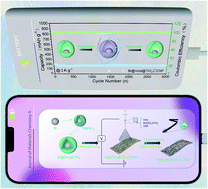Coupling core–shell Bi@Void@TiO2 heterostructures into carbon nanofibers for achieving fast potassium storage and long cycling stability†
Abstract
Bismuth (Bi) has been regarded as a promising anode material for potassium-ion batteries (PIBs) due to its high theoretical capacity (386 mA h g−1). However, the accompanying drastic volume change during charge/discharge processes has seriously hindered its practical application in PIBs. Herein, a multi-core–shell heterostructured Bi@Void@TiO2 embedded in one-dimensional carbon nanofibers (CNF) is synthesized to solve this problem. Specifically, the chamber between the Bi core and TiO2 shell can buffer the volume change of Bi, and the TiO2 shell not only effectively prevents carbon skeleton collapse during carbonization, but also inhibits the agglomeration of Bi during alloying/dealloying. Importantly, theoretical calculations confirm that the heterostructures between the TiO2 shell and Bi/carbon facilitate the reaction kinetics of K+. As a PIB anode, the Bi@Void@TiO2⊂CNF electrode presents a high capacity of 388.8 mA h g−1 at 0.05 A g−1, and a remarkable capacity of 171.6 mA h g−1 at 2 A g−1 after 3000 cycles with a capacity retention of 85.4%. Moreover, a K-ion full cell based on a Bi@Void@TiO2⊂CNF anode can afford stable capacity retention over 1500 cycles at 1 A g−1. This work offers a promising strategy to design long-lived PIB anodes that show potential for practical applications.



 Please wait while we load your content...
Please wait while we load your content...